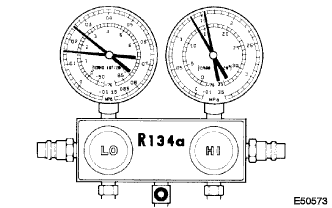Vehicle Interior. Yaris. Ncp93, 131
Heating Air Conditioning. Yaris. Ncp93, 131
Refrigerant (For Sedan) -- On-Vehicle Inspection |
| 1. CHECK REFRIGERANT PRESSURE USING MANIFOLD GAUGE SET |
This is a method to identify trouble areas by using a manifold gauge set. Read the manifold gauge pressure under the following conditions.
Test conditions:- Engine warm.
- All doors fully open.
- A/C switch ON.
- Blower speed control switch at HI.
- Engine running at 1,500 rpm.
- Air inlet mode damper set at recirculation.
- Temperature control lever in MAX. COLD position.
- Air temperature at air inlet 30 to 35°C (86 to 95°F).
When the refrigerant volume is correct, the gauge reading indicates as follows:
- Low pressure side:
- 0.15 to 0.25 MPa (1.5 to 2.5 kgf/cm2)
- High pressure side:
- 1.37 to 1.57 MPa (14 to 16 kgf/cm2)
- HINT:
- Pressure varies in accordance with certain conditions (outside air temperature, sunlight and wind).
When there is moisture in the refrigeration system:

Symptoms Probable Cause Diagnosis Corrective Actions During operation, pressure on low pressure side cycles between normal and vacuum Moisture in refrigeration system freezes at expansion valve orifice, causing temporary interruption of cycle
However, when melted, returns to normal condition- Receiver dryer oversaturated
- Moisture in refrigeration system freezes at expansion valve orifice and blocks refrigerant circulation
- Replace receiver dryer
- Remove moisture from cycle by repeatedly evacuating air
- Supply appropriate volume of new refrigerant
- Receiver dryer oversaturated
When cooling is insufficient:

Symptoms Probable Cause Diagnosis Corrective Actions - Pressure low on both low and high pressure sides
- Cooling performance insufficient
Gas leakage from refrigeration system - Insufficient refrigerant
- Refrigerant leakage
- Check for gas leakage using gas leak detector, and repair if necessary
- Supply appropriate volume of new refrigerant
- If indicated pressure value close to 0 when connected to gauge, create vacuum after inspecting and repairing location of leakage
- Pressure low on both low and high pressure sides
When the circulation of the refrigerant is poor:

Symptoms Probable Cause Diagnosis Corrective Action - Pressure low on both low and high pressure sides
- Frost exists on piping from condenser to A/C unit
Refrigerant flow obstructed by dirt in condenser Condenser clogged Replace condenser - Pressure low on both low and high pressure sides
When the refrigerant does not circulate:

Symptoms Probable Causes Diagnosis Corrective Actions - Vacuum indicated on low pressure side, and extremely low pressure indicated on high pressure side
- Frost or condensation seen on piping on both sides of condenser or expansion valve
- Refrigerant flow obstructed by moisture or dirt in refrigeration system
- Refrigerant flow obstructed by gas leakage from expansion valve
Refrigerant does not circulate - Check expansion valve
- Clean expansion valve with compressed air
- Replace condenser
- Evacuate air and then supply appropriate volume of new refrigerant
- For gas leakage from expansion valve, replace expansion valve
- Vacuum indicated on low pressure side, and extremely low pressure indicated on high pressure side
When the refrigerant is overcharged or cooling of condenser is insufficient:

Symptoms Probable Causes Diagnosis Corrective Actions Pressure extremely high on both sides - Excessive refrigerant
- Cooling performance of condenser insufficient
- Excessive refrigerant
- Cooling performance of condenser insufficient
- Clean condenser fins
- Check condenser fan motor operation by switching A/C ON
- If 1 and 2 normal, check amount of refrigerant and supply appropriate volume of refrigerant
- Excessive refrigerant
When there is air in the refrigeration system:

Symptoms Probable Causes Diagnosis Corrective Actions - Pressure extremely high on both low and high pressure sides
- Low pressure piping too hot to touch
Air in refrigeration system - Air in refrigeration system
- Insufficient vacuum purging
- Check whether compressor oil dirty or insufficient
- Evacuate air and supply new refrigerant
- Pressure extremely high on both low and high pressure sides
When the expansion valve malfunctions:

Symptoms Probable Causes Diagnosis Corrective Actions - Pressure extremely high on both low and high pressure sides
- Frost or condensation on piping on low pressure side
Expansion valve malfunction - Excessive refrigerant in low pressure piping
- Expansion valve opening too wide
Replace expansion valve - Pressure extremely high on both low and high pressure sides
When the compressor is defective:

Symptoms Probable Cause Diagnosis Corrective Actions - Pressure extremely high on both low and high pressure sides
- Pressure extremely low on high pressure side
Internal leakage in compressor - Compression failure of compressor
- Leakage from damaged valve or broken sliding parts in compressor
Repair or replace compressor - Pressure extremely high on both low and high pressure sides

- Engine warm.
| 2. INSPECT IDLING SPEED |
Warm up the engine.
Inspect the idling speed when these conditions are established.
- Engine warm
- Transmission shifted to either the neutral or the parking position.
- Standard:
- for manual transaxle:
Condition Idling Speed Switch A/C OFF 550 to 650 rpm Switch A/C ON (A/C Lo → Hi) 700 → 850 rpm - for automatic transaxle:
Condition Idling Speed Switch A/C OFF 650 to 750 rpm Switch A/C ON (A/C Lo → Hi) 700 → 850 rpm
- Engine warm